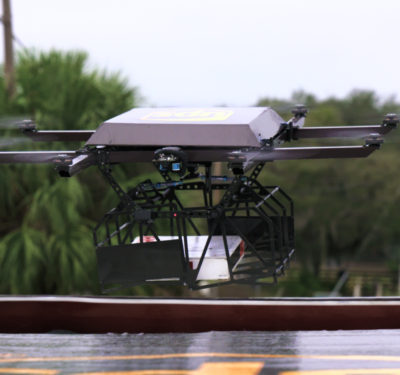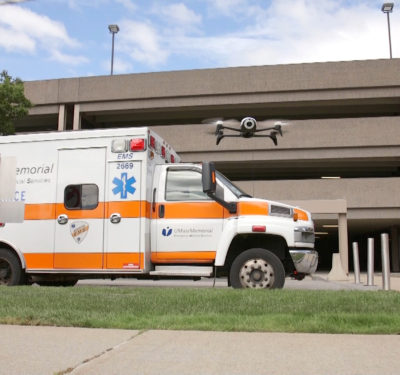The energy industry can greatly benefit from drone inspections, not just by cutting costs but by preventing disasters and saving lives. Drones can eliminate the need for hazardous climbing to check on wind turbines. They can empower decisions at utility-scale solar farms without needing to examine thousands of panels by hand or extrapolate from just a sampling of panels to identify systemic problems. Drone use also can preclude putting manned aircraft in hazardous positions.
Suzanne Lemieux, the American Petroleum Institute’s expert on unmanned aerial systems (UAS), reinforced this utility. “There are lots of places in refineries where inspections might be difficult, or would create a dangerous situation for a person to climb around certain equipment. Drones can make inspections a lot safer and easier by, for instance, flying up stacks instead of having plants shut down operations in order for inspectors to climb up.”
Now, standards for drone operations that are under development may help expand the use of unmanned aircraft services in the energy industry.
THE NEED FOR STANDARDS
Developing standards when it comes to drone applications for the energy industry would “help drones get used in the best possible to collect the best-quality data, and so help promote safety and efficiency,” said Luis Pulgarin, who manages the mobile unmanned systems standards committee for the American Society of Mechanical Engineers (ASME).
“When you have standards for operations in place, those inspections you conduct with drones start to hold more and more weight,” said Burton Putrah, vice president of data engineering at drone services firm Measure, which has been involved across the energy/inspection field (see other stories for more on the company’s work). “Standards might help drive innovation within the drone industry—if you expect to see a certain quality of data associated with inspections, it helps the industry move toward better imagery and other data.”
However, much remains uncertain when it comes to what standards to expect for drone applications in the energy industry. For solar operations and management inspections, “there are certain accuracy requirements for surveys, such as if you are doing stockpile measurements or mapping missions,” Putrah said. “But when it comes to wind turbine inspections, it’s kind of the Wild West. I think there could be a standardized number of acceptable images or minimum resolution for images, such as what you would need to detect cracks in a blade.”
The energy industry often adopts a “wait and see” approach when it comes to drones because of the rapid pace at which the technology is advancing, Lemieux said. “Advanced applications such as beyond visual line of sight flights are more applicable for the oil and gas industry,” she noted. “As the marketplace changes, we are waiting to see what are going to emerge as the best tools out there, which might then go on to drive standards forward that would prove to be important in our industry.” (See “Five Good Questions” on page 66 for more of her thoughts.)
STANDARDS UNDER DEVELOPMENT
To help advance the current state of drone standards, ASME is currently developing two sets of norms for visual inspections using unmanned aircraft—one for power plants, and the other for cranes. “We are also looking into inspections for offshore wind energy,” Pulgarin said.
Specifically, when it comes to energy-related drone inspections, ASME is drafting a document of what inspectors and drone owner-operators might need to know for such missions. “A situation that seems to happen nowadays is you get fly-by-night operations where an 18-year-old buys a drone from Best Buy and they think they’re a pilot now,” Pulgarin said. “So, this document talks about how to filter out those types of people.”
Five case studies of energy-industry-related drone inspections are envisioned for the ASME document. “The first is how to inspect a boiler,” Pulgarin said. “The second is inspecting a nuclear dome. The third is a stack, such as a smokestack. The fourth is a nuclear power plant. The last is piping.”
Each case study examines a different challenge. Boilers are indoor environments, while nuclear domes are outdoors. In contrast, “a stack is a hybrid that you can inspect from the inside or the outside,” Pulgarin said. A nuclear power plant presents a hazardous environment, while piping can be either indoor or outdoor. ASME envisions completing this document in roughly two years, Pulgarin added.
BEYOND VISUAL LINE OF SIGHT
To make inspections of pipelines and power lines over long distances practical, flights that go beyond the visual line of sight (BVLOS) are needed. “There are a few approved BVLOS operations out there, but no fly-on-demand BVLOS operations, really,” said Philip Kenul, F38 chairman of the unmanned aircraft systems committee at ASTM International (originally the American Society for Testing and Materials).
A first step toward BVLOS expansion is to conduct limited flights in airspace segregated from outside challenges. But, Kenul continued, “for a lot of BVLOS operations you would want to conduct with, say, pipelines and power lines, you can’t rely on segregating airspace—they go all over the place, and it is not practical to restrict all airspace around them. In the future, you have to assume multiple operations may take place along a corridor—maybe one pilot is surveying a railroad, while another is surveying a pipeline—and you have to think about ways to make sure they can all act in concert in the same airspace at the same time.”
Standards for systems are a key step to help unmanned aircraft detect and avoid obstacles such as other aircraft in the same airspace, Kenul said. “It is difficult to get true BVLOS because detect-and-avoid technology is not advanced enough yet, but we are now starting to get advanced EO/IR [electro optical/infrared] sensors, acoustic sensors, machine learning, ground-based radar and other technologies to support improved detect-and-avoid systems.”
ASTM International has formed a committee to develop a roadmap for true BVLOS operations, “to look at what has been done so far, to look at what the gaps are, and find out what standards are required,” Kenul said. “The goal is to turn it around in about a year.”
UAS TRAFFIC MANAGEMENT AND REMOTE ID
Other standards that could advance energy industry drone applications involve UAS traffic management (UTM). “If you want to have drones working side by side with each other—say, power line inspections next to package delivery—you need to manage the traffic in that airspace,” Kenul said.
Here, remote ID systems would act much like electronic license plates that drones could use to identify themselves to remote observers. In September, Kenul and his colleagues submitted guidelines for such remote ID systems to ASTM International for approval; these were developed with input from civil aviation authorities such as the U.S. Federal Aviation Administration (FAA) and Transport Canada, as well as DJI, Amazon, Google Wing and other leaders in the drone industry.
Kenul and his colleagues envision drones continuously broadcasting ID data via Bluetooth or Wi-Fi as part of the signals such technologies normally transmit to permit other devices to discover and connect with the broadcasting device. These ID signals may be readable from a distance of up to 450 meters. (Intel has conducted studies suggesting that when Bluetooth 5 comes out, ID signals may be readable from a range of up to a kilometer, Kenul added.)
Apps on smartphones or other devices could then connect to the internet to look up information on a drone. The public will likely only be able to read the ID number of the drone, which the standard’s developers suggested might be the drone’s serial number, or a registration number from the FAA or other civilian aviation authority. Law enforcement and other authorities would be able to get more information about the drone from its ID data, such as its latitude, longitude, altitude, speed, direction, and takeoff point, plus its owner and operator data, and the stated purpose of the flight.
A drone can also be identified from its ID data if it is connected to the internet; say, over a cellular or satellite link through its operator. This alternative can prove helpful if an observer does not have the remote ID app, or if the drone is out of range or moving too quickly for the app to acquire its Bluetooth or Wi-Fi signals, or if humidity levels in the air are high enough to degrade the Bluetooth or Wi-Fi signals. If ASTM approves this standard and FAA uses it as the basis of its rules for remote ID, new drones may come automatically outfitted with such electronic license plates. Old drones can be retrofitted with ID chips that would plug into their USB ports and might cost $7 to $12, Kenul said.
Remote ID is not only a key building block for UTM; it also supports the energy industry in many ways, Kenul said. “Folks want to know what’s flying around their power plant, their power lines, their dams,” he said. “It’s very important for the Department of Homeland Security, the Department of Justice and the Department of Defense to identify who may own and operate such aircraft.”
PROFICIENCY TESTS FOR DRONES AND PILOTS
Recent advances with standards in drone applications for emergency services may help lead to proficiency tests for drones and pilots in the energy industry. Researchers at the Department of Homeland Security and the National Institute of Standards and Technology (NIST) developed five basic methods to test drone maneuverability and another five to assess the basic functionality of drone sensor payloads. Their goal is for these methods to become global standards with ASTM International.
Key to each test method are white buckets with inscribed rings within them to make their bottoms look a bit like archery targets. These circles provide clear signs to pilots that they’ve successfully aligned their drones with the buckets. Navigating a series of these buckets can test how quickly and accurately drones can be flown to and stop at designated locations to examine desired targets. Visual acuity charts can also be placed within the buckets to determine how well pilots can see details with a drone’s camera. Challenges such as windiness can get simulated using fans. (For more details, see “Emergency Response Drones Meet New Standards” in the August-September issue of this magazine.)
The aim of these methods is to help one measure and compare how well pilots and drones perform on key tasks in a simple, inexpensive, quantitative and scalable manner. Ultimately, such test methods could find use in credentialing exams.
“These test methods were originally developed for emergency response missions, but others could use these test methods to assess pilots for other requirements, such as the particular ways the oil and gas industry might want to carry out a specific survey,” Kenul said.
For instance, when it comes to wind turbine inspection, “one might want standards for how far away operators can be from blades with given sensors so you can have a certain confidence level that you are capturing data that is good enough to accurately determine cracks or delamination on a blade,” Putrah said. “That’s key to making sure that catastrophic failures of blades don’t happen between maintenance cycles.”
FUTURE DIRECTIONS
Once standards are put forth for energy-related drone visual inspections, ASME plans on looking at guidelines for other forms of robotic inspection, such as ones using crawlers and subsea vehicles. “Instead of just visual inspections, we may also investigate other inspection methods, such as using ultrasound, X-rays, magnetic sensors,” Pulgarin said.
Ultimately, energy-related drone applications may move beyond inspection “to repair and replacement activities,” said Ryan Crane, the director of American Society of Mechanical Engineers’ standards and certification initiatives. “Might we see unmanned aircraft do welding procedures? I would guess we are still a long way from there, but that may be where the field is going.” And standards will go with it.






